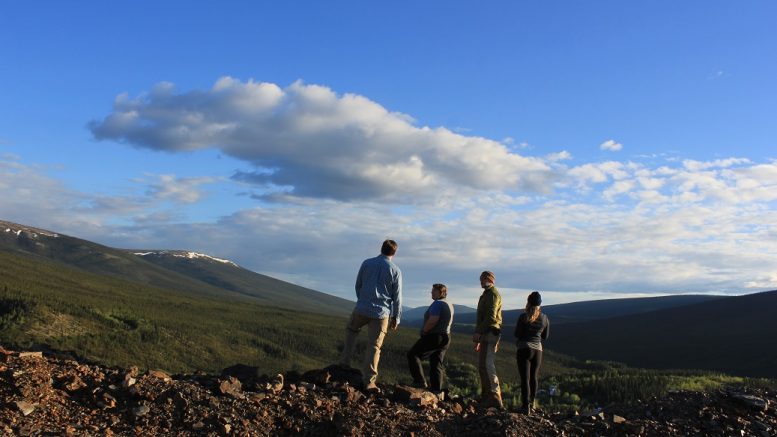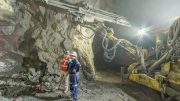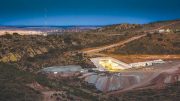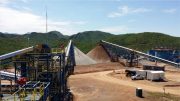Metallic Minerals (TSXV: MMG; US-OTC: MMNGF) is wrapping up its $2.5-million summer work program in the Yukon.
The company fanned out across both its Keno silver district and McKay silver-lead-zinc district in the territory. It found several mineralized vein structures and is refining next year’s drill targets.
Last year the Metallic team got on the ground at McKay and realized the property housed more vein structures than it had thought — particularly on the Central zone, which saw high-grade production in the 1930s and 1940s.
This year Metallic fielded a larger program to examine more of the property and extend the mineralized zones. The company performed geophysical surveying and detailed satellite photography, dug 16 trenches and took more than 700 soil samples.
As a result, Metallic staked another 42 claims, expanding the property 25% to 44 square kilometres.

Metallic recently expanded its McKay Hill silver project 25%. Credit: Metallic Minerals.
“What was exciting was that rather than a handful of discrete veins, there was quite a large mineralized corridor, approaching a kilometre in length, with multiple vein sets — particularly in this main area of the Central zone,” Metallic CEO Greg Johnson says during an interview with The Northern Miner.
“It’s starting to suggest you could have a bulk-mineable target in there.”
Johnson says Metallic’s work program at Keno was more multifaceted because the project is more advanced. According to him, Keno hosts three stages of targets.
One category includes the Caribou, Homestake and Formo targets, where the company is in the early stages of developing resources; a second features six targets that are drill-ready, with trenches or records of past production; and the third has 20 targets at the stage of refinement.
At Caribou and Homestake, the company stepped out along structural corridors, drilling 2,000 metres between the two targets. Neither target hosts just a single vein, but, rather, a package of veins within a structural corridor.
The company spent $2 million at Keno and the other $500,000 at McKay. It is planning its mid-2019 programs. It recently closed a $1.54-million private placement, and is generating a small amount of income from royalties on its Australia Creek alluvial gold property, in the southeastern part of Yukon’s Klondike gold district.
The company assembled the package of alluvial claims last year. Johnson says bucket line dredges mined the surrounding area during the 1920s to 1970s, but used Australia Creek’s drainage system as a water source, so the area was never mined.
Last year the company signed two lease agreements on two claim blocks covering nearly 8 kilometres. It recently leased another two blocks that cover 10.5 kilometres. In exchange, Metallic receives a minimum 10% royalty on all gold production from the area.
“A lot of the alluvial operators are small to mid-size companies,” Johnson says. “They don’t have exploration teams to go out and assemble land packages. We’re doing what we already do for the hard rock business, and then offering the land to experienced operators.”
Before leasing the land, Metallic compiled historic drilling and performed geophysics, auger drilling and limited bulk sampling.

The Metallic field team examines core at its Keno Hills silver project. Credit: Metallic Minerals.
“The testing that has been done by these initial operators in their bulk samples, and drilling, is showing significant alluvial gold,” Johnson says. “It’s a good selling point for a new party.”
As Metallic leases the lower parts of Australia Creek, it creates access to the upper reaches. The operators that come in create road and infrastructure access, incrementally developing the area. There is enough space to eventually host at least 10 operators. Metallic is permitting another 39 km of Australia Creek and its tributaries, which would help bring in another six operators.
“The idea is, this gives us cash flow and sustainability,” Johnson says. “Over time this could become a fairly significant revenue-generating element of our business while we continue to concentrate on our core focus, which is exploration for high-grade silver in the eastern Yukon.”
Meanwhile, the company recently announced the establishment of the Metallic Group, a collaboration with platinum-group-metal (PGM) and nickel-focused Group Ten Metals (TSXV: PGE; US-OTC: PGEZF) that will soon include a third company, copper explorer Granite Creek Copper (TSXV: GCX), after it launches with its flagship property in Yukon’s Carmacks copper belt.

Workers near a drill rig at Metallic Minerals’ Keno Hill silver project in the Yukon. Credit: Metallic Minerals.
The Metallic Group shares an office, chief financial officer and administration team. This allows all three companies to hire specialized technical people by lowering overhead and pooling experienced board members.
“All three have a common business plan: acquire large, brownfield district packages next to operating mines, and systematically explore them,” Johnson says.
Metallic’s Keno silver project sits next to Alexco Resource’s (TSX: AXR; NYSE-AM: AXU) Keno Hill project, Group Ten’s Stillwater West PGM-nickel-coper project sits next to Sibanye-Stillwater’s (NYSE: SBGL) Stillwater and East PGM mines, and Granite Creek will be next to Capstone Mining’s (TSX: CS; US-OTC: CSFFF) Minto copper mine.
Shares of Metallic are trading at 23¢ within a 52-week range of 21¢ to 50¢. The company has a $14-million market capitalization.





Be the first to comment on "Metallic finds more veins at Keno and McKay Hill districts"